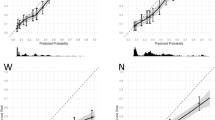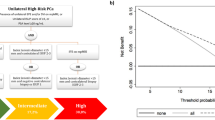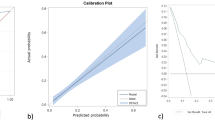Abstract
Purpose
Accurate prediction of extraprostatic extension (EPE) is pivotal for surgical planning. Herein, we aimed to provide an updated model for predicting EPE among patients diagnosed with MRI-targeted biopsy.
Materials and methods
We analyzed a multi-institutional dataset of men with clinically localized prostate cancer diagnosed by MRI-targeted biopsy and subsequently underwent prostatectomy. To develop a side-specific predictive model, we considered the prostatic lobes separately. A multivariable logistic regression analysis was fitted to predict side-specific EPE. The decision curve analysis was used to evaluate the net clinical benefit. Finally, a regression tree was employed to identify three risk categories to assist urologists in selecting candidates for nerve-sparing, incremental nerve sparing and non-nerve-sparing surgery.
Results
Overall, data from 3169 hemi-prostates were considered, after the exclusion of prostatic lobes with no biopsy-documented tumor. EPE was present on final pathology in 1,094 (34%) cases. Among these, MRI was able to predict EPE correctly in 568 (52%) cases. A model including PSA, maximum diameter of the index lesion, presence of EPE on MRI, highest ISUP grade in the ipsilateral hemi-prostate, and percentage of positive cores in the ipsilateral hemi-prostate achieved an AUC of 81% after internal validation. Overall, 566, 577, and 2,026 observations fell in the low-, intermediate- and high-risk groups for EPE, as identified by the regression tree. The EPE rate across the groups was: 5.1%, 14.9%, and 48% for the low-, intermediate- and high-risk group, respectively.
Conclusion
In this study we present an update of the first side-specific MRI-based nomogram for the prediction of extraprostatic extension together with updated risk categories to help clinicians in deciding on the best approach to nerve-preservation.
This is a preview of subscription content, access via your institution
Access options
Subscribe to this journal
Receive 4 print issues and online access
$259.00 per year
only $64.75 per issue
Buy this article
- Purchase on Springer Link
- Instant access to full article PDF
Prices may be subject to local taxes which are calculated during checkout


Similar content being viewed by others
Data availability
Data is available for bona fide researchers upon request
References
Martini A, Falagario UG, Villers A, Dell’Oglio P, Mazzone E, Autorino R, et al. Contemporary techniques of prostate dissection for robot-assisted prostatectomy. Eur Urol. 2020;78:583–91.
Ficarra V, Borghesi M, Suardi N, De Naeyer G, Novara G, Schatteman P, et al. Long-term evaluation of survival, continence and potency (SCP) outcomes after robot-assisted radical prostatectomy (RARP). BJU Int. 2013;112:338–45.
Suardi N, Moschini M, Gallina A, Gandaglia G, Abdollah F, Capitanio U, et al. Nerve-sparing approach during radical prostatectomy is strongly associated with the rate of postoperative urinary continence recovery. BJU Int. 2013;111:717–22.
Martini A, Gandaglia G, Fossati N, Scuderi S, Bravi CA, Mazzone E, et al. Defining clinically meaningful positive surgical margins in patients undergoing radical prostatectomy for localised prostate cancer. Eur Urol Oncol. 2021;4:42–8.
Martini A, Marqueen KE, Falagario UG, Waingankar N, Wajswol E, Khan F, et al. Estimated costs associated with radiation therapy for positive surgical margins during radical prostatectomy. JAMA Netw Open. 2020;3:e201913.
Martini A, Mottet N, Montorsi F, Necchi A, Ribal MJ, Malavaud B. A plea for economically sustainable evidence-based guidelines. Eur Urol. 2022;82:449–51.
Kozikowski M, Malewski W, Michalak W, Dobruch J. Clinical utility of MRI in the decision-making process before radical prostatectomy: Systematic review and meta-analysis. PLoS One. 2019;14:e0210194.
Martini A, Gupta A, Lewis SC, Cumarasamy S, Haines KG 3rd, Briganti A, et al. Development and internal validation of a side-specific, multiparametric magnetic resonance imaging-based nomogram for the prediction of extracapsular extension of prostate cancer. BJU Int. 2018;122:1025–33.
Soeterik TFW, van Melick HHE, Dijksman LM, Kusters-Vandevelde H, Stomps S, Schoots IG, et al. Development and external validation of a novel nomogram to predict side-specific extraprostatic extension in patients with prostate cancer undergoing radical prostatectomy. Eur Urol Oncol. 2020.
Nyarangi-Dix J, Wiesenfarth M, Bonekamp D, Hitthaler B, Schutz V, Dieffenbacher S, et al. Combined clinical parameters and multiparametric magnetic resonance imaging for the prediction of extraprostatic disease-A risk model for patient-tailored risk stratification when planning radical prostatectomy. Eur Urol Focus. 2020;6:1205–12.
Barentsz JO, Weinreb JC, Verma S, Thoeny HC, Tempany CM, Shtern F, et al. Synopsis of the PI-RADS v2 guidelines for multiparametric prostate magnetic resonance imaging and recommendations for use. Eur Urol. 2016;69:41–9.
Barentsz JO, Richenberg J, Clements R, Choyke P, Verma S, Villeirs G, et al. ESUR prostate MR guidelines 2012. Eur Radio. 2012;22:746–57.
Ohori M, Kattan MW, Koh H, Maru N, Slawin KM, Shariat S, et al. Predicting the presence and side of extracapsular extension: a nomogram for staging prostate cancer. J Urol. 2004;171:1844–9.
Martini A, Wever L, Soeterik TFW, Rakauskas A, Fankhauser CD, Grogg JB, et al. Unilateral pelvic lymph node dissection in prostate cancer patients diagnosed in the era of magnetic resonance imaging-targeted biopsy: a study that challenges the Dogma. J Urol. 2023;210:117–27.
Srivastava A, Chopra S, Pham A, Sooriakumaran P, Durand M, Chughtai B, et al. Effect of a risk-stratified grade of nerve-sparing technique on early return of continence after robot-assisted laparoscopic radical prostatectomy. Eur Urol. 2013;63:438–44.
Martini A, Cumarasamy S, Haines KG III, Tewari AK. An updated approach to incremental nerve sparing for robot-assisted radical prostatectomy. BJU Int. 2019;124:103–8.
Martini A, Tewari AK. Anatomic robotic prostatectomy: current best practice. Ther Adv Urol. 2019;11:1756287218813789.
Martini A, Soeterik TFW, Haverdings H, Rahota RG, Checcucci E, De Cillis S, et al. An algorithm to personalize nerve sparing in men with unilateral high-risk prostate cancer. J Urol. 2022;207:350–7.
Dinneen EP, Van Der Slot M, Adasonla K, Tan J, Grierson J, Haider A, et al. Intraoperative frozen section for margin evaluation during radical prostatectomy: A Systematic Review. Eur Urol Focus. 2020;6:664–73.
van der Slot MA, den Bakker MA, Tan TSC, Remmers S, Busstra MB, Gan M, et al. NeuroSAFE in radical prostatectomy increases the rate of nerve-sparing surgery without affecting oncological outcome. BJU Int. 2022;130:628–36.
Diamand R, Roche JB, Lievore E, Lacetera V, Chiacchio G, Beatrici V, et al. External validation of models for prediction of side-specific extracapsular extension in prostate cancer patients undergoing radical prostatectomy. Eur Urol Focus. 2023;9:309–16.
Pak S, Park S, Ryu J, Hong S, Song SH, You D, et al. Preoperative factors predictive of posterolateral extracapsular extension after radical prostatectomy. Korean J Urol. 2013;54:824–9.
Patel VR, Sandri M, Grasso AAC, De Lorenzis E, Palmisano F, Albo G, et al. A novel tool for predicting extracapsular extension during graded partial nerve sparing in radical prostatectomy. BJU Int. 2018;121:373–82.
Valerio M, Anele C, Freeman A, Jameson C, Singh PB, Hu Y, et al. Identifying the index lesion with template prostate mapping biopsies. J Urol. 2015;193:1185–90.
Nassiri N, Chang E, Lieu P, Priester AM, Margolis DJA, Huang J, et al. Focal therapy eligibility determined by magnetic resonance imaging/ultrasound fusion biopsy. J Urol. 2018;199:453–8.
Beksac AT, Cumarasamy S, Falagario U, Xu P, Takhar M, Alshalalfa M, et al. Multiparametric magnetic resonance imaging features identify aggressive prostate cancer at the phenotypic and transcriptomic level. J Urol. 2018;200:1241–9.
Author information
Authors and Affiliations
Consortia
Contributions
Study concept and design: Martini, Valerio. Acquisition of data: All authors. Analysis and interpretation of data: Martini, Valerio. Drafting of the manuscript: Martini, Valerio. Critical revision of the manuscript for important intellectual content: All authors. Statistical analysis: Martini. Supervision: Valerio.
Corresponding authors
Ethics declarations
Competing interests
AM and GP own equities of Oltre Medical Consulting, Toulouse, France. The other authors have no conflicts.
Additional information
Publisher’s note Springer Nature remains neutral with regard to jurisdictional claims in published maps and institutional affiliations.
Supplementary information
Rights and permissions
Springer Nature or its licensor (e.g. a society or other partner) holds exclusive rights to this article under a publishing agreement with the author(s) or other rightsholder(s); author self-archiving of the accepted manuscript version of this article is solely governed by the terms of such publishing agreement and applicable law.
About this article
Cite this article
Martini, A., Wever, L., Soeterik, T.F.W. et al. An updated model for predicting side-specific extraprostatic extension in the era of MRI-targeted biopsy. Prostate Cancer Prostatic Dis (2024). https://doi.org/10.1038/s41391-023-00776-x
Received:
Revised:
Accepted:
Published:
DOI: https://doi.org/10.1038/s41391-023-00776-x



